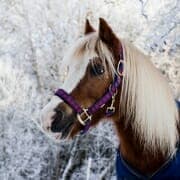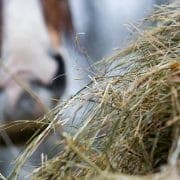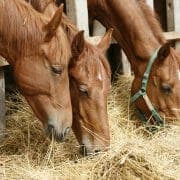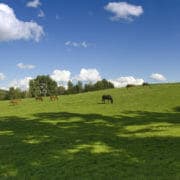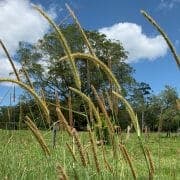Mycotoxin Binders: Do They Work on Pasture Toxins?
There has been a lot of talk in recent years about the effect pasture mycotoxins are having on our horses and whether or not mycotoxin binders are an effective solution. While the extreme cases of staggers and pregnancy complications from grasses like perennial ryegrass and tall fescue are well documented it appears that pasture mycotoxins may be having more subtle effects on our horses that until recently have not been well recognised.
In an attempt to reduce the impact of the mycotoxins present in pastures many horse owners have been using mycotoxin binders. But do they work?
The problem with pastures
Some species of ryegrass and tall fescue are inoculated deliberately or infected with wild endophyte fungi. These fungi live within the plant in a symbiotic relationship where the plant provides the fungi with food and a place to live, and the fungi provide the plant with protection from insect and nematode attack by producing toxic chemicals or mycotoxins which cause a disease in some grazing animals called a mycotoxicosis. So, while the endophyte infected pastures are desirable from a pasture production perspective, the toxins they may contain can cause health problems for your horses. Horses grazing these pastures may exhibit some or all of the following clinical signs:
- Reduced appetite
- Weight loss or reduced growth rates
- Inability to correctly regulate body temperature
- Diarrhoea
- Excitable, unpredictable, irritable or uncharacteristic behaviour
- Over-reaction to common stimulus they would normally be OK with
- Muscle twitching or twitching of the face, lips and eyelids
- Prolonged pregnancy and thickened or retained placenta
- Aborted or small, ‘undercooked’ foals
- Dramatically reduced milk production by mares in early lactation
- Loss of coordination, especially in the hind end, and staggering
- Severe lameness
- Bleached and/or rough coat
These possible symptoms are obviously very broad and many of them can be caused by any number of other factors, so you need to be very, very careful not to jump to conclusions and assume that the problems you are seeing in your horses are caused by mycotoxins in your pasture. if you have ruled out other possible causes and your horse is grazing a pasture that is potentially ‘poisoning’ them, then chances are what you are seeing is a mycotoxicosis.
Which mycotoxins are present in pasture?
Potentially, there could be any number of mycotoxins in your pasture as common moulds or fungi like Aspergillus, Fusarium and Penicillium can produce mycotoxins when growing on pasture. However, the mycotoxins most likely present in perennial ryegrass and tall fescue pastures that will cause issues are ergovaline and lolitrem B.
What are mycotoxin binders?
A mycotoxin binder is a compound that can be added to a horse’s ration in an attempt to grab hold of a mycotoxin that may be present in feed or pasture, binding it strongly enough to prevent absorption from the gut of the animal.
There are many materials that can be used as mycotoxin binders including activated carbon, aluminosilicates like zeolite, cellulose, polysaccharides that are found in the cell walls of yeast and some bacteria (eg glucomannans) and even some synthetic materials.
Do all binders bind all mycotoxins?
In a word… NO! And this is where a major key lies to whether mycotoxin binders will work to prevent pasture associated mycotoxin poisoning or not. For example, it has been shown that glucomannan from the yeast Saccharomyces cerevisiae is very effective at binding aflatoxin (one of the most important and prevalent mycotoxins present in grain-based livestock feeds) and good ability to bind the fumonisin and zearalenone mycotoxins, but it is ineffective when it comes to binding other important mycotoxins like T-2 (trichothecene), DON (deoxynivalenol) and ochratoxin.
Why don’t all binders work on all mycotoxins?
One of the reasons some binders can bind some mycotoxins and not others is dependent on the mycotoxin itself and whether it is polar (possessing an electrical charge) or not. Aflatoxin for example is a polar mycotoxin and is very easily ‘picked up’ by a yeast derived glucomannan based binder (which are the most common mycotoxin binders on the market for horses). The pasture-based mycotoxins ergovaline and lolitrem B on the other hand are non-polar (no charge) so trying to pick them up with a yeast cell wall-based toxin binder is sort of like trying to pick up a piece of paper with a magnet … it just won’t work.
Where does that leave us with pasture mycotoxins and my horse?
Well… unfortunately there is very little research to show what may or may not work with regards to pasture toxins. None of the companies that manufacture or sell the yeast-based binders have (from what I can see) ever released data to show their products are effective against lolitrem B and ergovaline in any animal species, let alone horses. Research at the University of Melbourne is showing promising results with a new mycotoxin binder in reducing the impact of ergovaline and lolitrem B in sheep. This toxin binder as well as one or two others now on the market for the more common mycotoxins are a new type of ‘binder’ that combines the ability to bind mycotoxins with the ability to also break them down and deactivate them – presumably it is this double mode of action that is enabling them to be somewhat effective in reducing the impact of the endophyte toxins like ergovaline and lolitrem B.
What do you do now?
If you believe your horse is affected by pasture mycotoxins and you are using a mycotoxin binder, it would be a good idea to contact the company you are buying the binder from and asking them what the binder is and whether they have data to show it actually binds the endophyte mycotoxins affecting your horse. If it is a yeast-based binder it is unlikely to be reducing the effects of ergovaline and lolitrem B but you may still be seeing a positive effect if your other feed, hay or chaff is contaminated with one of the common mycotoxins that these yeast-based binders are good at binding.
Really the best way to reduce the impact of ergovaline and lolitrem B is to either remove the horses completely from the pasture, especially during late summer and autumn when endophyte mycotoxin levels are likely to peak. Alternatively, manage your pastures well by preventing both overgrazing and underutilisation of pasture (allowing pastures to go rank/long with many seed heads) so that the risk of ergovaline and lolitrem B ingestion is reduced. Providing mycotoxin free hay to reduce pasture intake will also help.
Not yet a Member of FeedXL?
Get EVEN MORE practical and personalised feeding guidance when you sign up to FEEDXL.
Do you have a question or comment? Do you need help with feeding?
We would love to welcome you to our FeedXL Horse Nutrition Facebook Group. Ask questions and have them answered by PhD and Masters qualified equine nutritionists and spend time with like-minded horse owners. It’s free!
Click here to join the FeedXL Horse Nutrition Facebook Group



